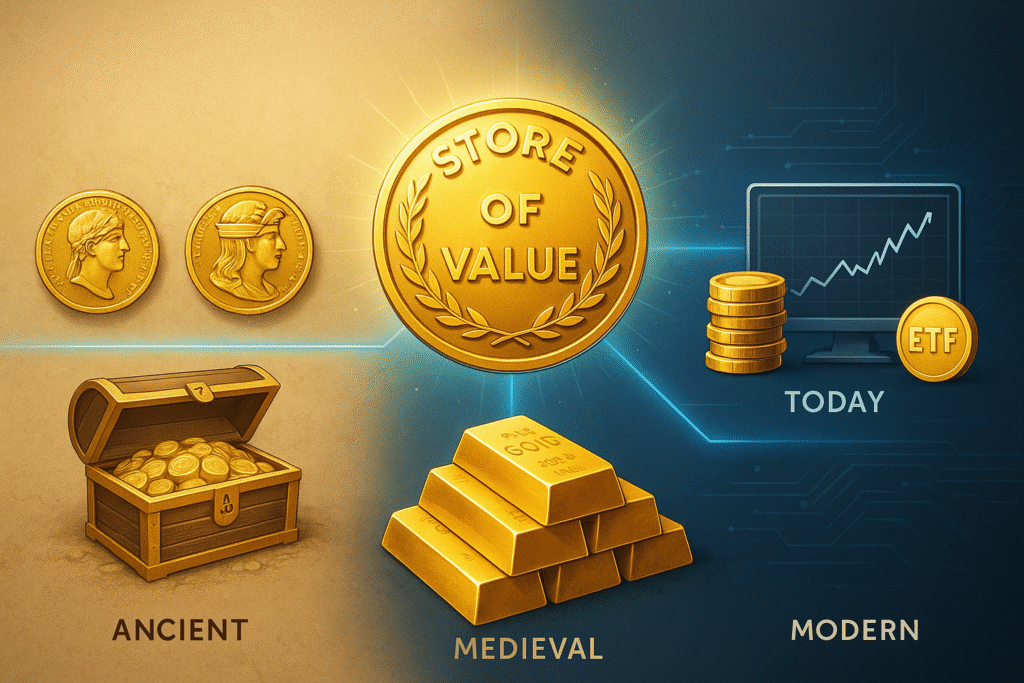Why Investing in Gold Still Matters in the Age of Crypto, Stocks, and Real Estate
Investing in Gold has stood the test of time — not just as a metal of beauty or power, but as the bedrock of personal and institutional wealth for millennia. While modern investors often chase high-yielding stocks, volatile cryptocurrencies, and booming real estate markets, the true gold standard of long-term investment discipline lies, quite literally, in gold itself.
In this blog, we explore why gold continues to remain relevant, its strategic place in long-term wealth building, and how to treat it as the ultimate personal hedge — not just a speculative trade.
Gold: Humanity’s First and Most Enduring Asset

From the ancient Egyptians and Roman Empire to central banks and billionaires today, gold has been the one asset that nearly every era, economy, and elite trusted.
Why?
Because unlike fiat currencies, stocks, or real estate — gold:
Doesn’t rust, rot, or expire
Doesn’t depend on governments or boardrooms
Cannot be printed or duplicated
Carries universal recognition and liquidity across geographies
This makes it a timeless store of value. Gold has protected civilizations through wars, hyperinflation, depressions, and even pandemics. It’s not flashy, fast, or exciting — but it is reliable, resilient, and quietly powerful.
Not a Speculative Trade, But a Strategic Allocation
One of the biggest misconceptions today is treating investing in gold like any other short-term tradeable asset — comparing its return to tech stocks or cryptocurrencies.
That’s the wrong lens.
Gold isn’t meant to deliver massive short-term capital gains. It’s not built for rapid rotation or aggressive yield. Instead, its real purpose is preservation, stability, and balance.
Gold is:
Low in long-term volatility
Highly liquid (in most global markets, anytime)
Uncorrelated to many risk-on assets (like stocks or crypto)
A universal hedge during economic, currency, or geopolitical crises
It shines brightest when everything else is uncertain — making it the ideal foundation or fallback for personal and family wealth.
Liquidity and Hedge Power: The Real Value of Investing in Gold
Let’s break this down further.
1. Extreme Liquidity
You can convert gold into cash almost anywhere in the world — instantly and at a relatively predictable market price. Unlike real estate or startup equity, gold doesn’t require weeks of paperwork or negotiations to liquidate.
2. Crisis Hedge
When markets crash, currencies fail, or banks freeze withdrawals, gold retains trust. It’s psychologically and systemically embedded as a “safe haven”.
3. Currency Buffer
Gold often rises when fiat currencies lose purchasing power — making it a long-term inflation hedge, especially in emerging or unstable economies.
Gold’s Volatility Is the Opportunity, Not the Risk
Although gold is relatively low-volatility compared to assets like crypto or equities, it occasionally experiences spikes in momentum — often triggered by global events, inflation scares, or speculative frenzies.
These short-term swings (often a few times per decade) offer tactical entry or exit windows. For long-term holders, these are the rare times to:
Rebalance positions upward or downward
Rotate some gains into other assets like stocks or real estate
Deploy capital into gold if other assets are overpriced or in decline
This makes gold not just a passive holding, but a smart pivot point in an investor’s overall portfolio strategy.
How Much Gold Should You Own? The 2–8% Rule
Most financial experts and hedge fund models agree that gold should occupy at least a small, permanent place in your total wealth.
Based on best practices:
A minimum 2% allocation helps preserve purchasing power and hedge volatility.
An optimal 5–8% allocation allows for strategic flexibility during crises or inflationary periods.
If you think of gold like your personal insurance, 2–8% is your policy premium for stability and liquidity — ready to help when you need it most.
Using Investing in Gold to Pivot Between Asset Classes

Here’s where things get interesting. Let’s say you maintain 5% of your net worth in gold:
Over time, based on the macroeconomic cycle, you may:
Sell gold during major price spikes to buy undervalued real estate
Shift some into stock markets during a correction
Re-enter gold when currencies are devaluing or inflation is peaking
Hedge your crypto profits by rotating into physical gold
This is the real tactical strength of gold: it doesn’t just sit still — it becomes the launchpad to optimize other investments when market cycles rotate.
You won’t get this level of cross-asset utility from cash, stocks, or even most bonds.
Gold and the Modern Investor: Compatibility with Digital Wealth
“But isn’t gold outdated in the age of Bitcoin and blockchain?”
That’s a fair question. While crypto has emerged as digital gold, it’s still inherently riskier, more volatile, and more speculative. The two aren’t competitors — they’re complements.
In fact, modern portfolios often hold:
5–10% crypto for asymmetric upside
5–8% gold for preservation, protection, and liquidity
This gives you a yin-yang balance — aggressive innovation on one side, ancient reliability on the other.
Key Takeaways: The Gold Standard for Gold Investing
Gold is not a get-rich-quick asset — it’s a stay-rich, stay-safe strategy
Keep 2–8% of your total wealth in gold to hedge against volatility, inflation, and uncertainty
Watch for rare volatility spikes as opportunities to reposition
Use gold as a liquidity hub to rotate into other undervalued asset classes
Combine gold with modern alternatives (like crypto) for a balanced, future-ready portfolio
Final Thoughts

If you’re serious about building long-term wealth, gold deserves a permanent seat at your table. It’s not about chasing returns — it’s about protecting the foundation on which you build.
Because when uncertainty rises and other assets wobble, gold doesn’t panic.
It waits.
It holds value.
And when the time is right, it gives you the clarity and power to move wisely.
That’s why it’s still called the gold standard — and always will be.
DYOR. Diversify. Rotate wisely.
Disclaimer: This is not financial advice. Always consult a professional and do your own research before making investment decisions.




